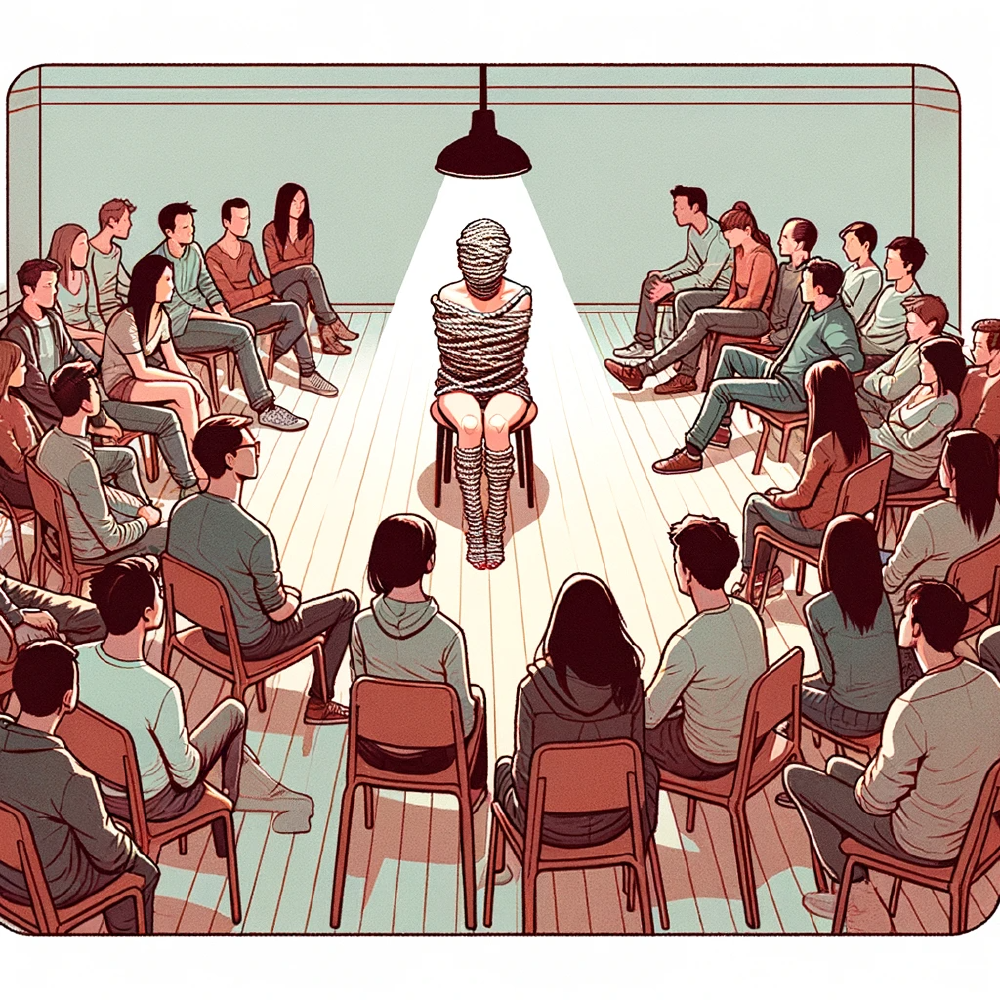BDSM for Beginners
Unfolding the Intricacies of Power & Pleasure
Published: January 22, 2024 (Updated: August 5, 2025)
Tags: BDSM Dominance Submission Bondage Discipline Sadism MasochismWe may make money when readers purchase items through our links. Disclosure

As we kick off our expansive series on BDSM, we start with the very basics: What exactly is BDSM? BDSM is a portmanteau of initialisms that represent several subcategories: Bondage/Discipline (B/D), Dominance/Submission (D/S), and Sadism/Masochism (S/M). It is an umbrella term that covers a broad range of sexual preferences, interests, and practices, each of them centred around a power exchange between consenting partners. Moreover, BDSM is not just about sexual activities; it is a distinct way of expressing and exploring relationships, advancing a unique balance of power, submission, and mutual respect.
Understanding BDSM involves recognizing that it is a practice of power exchange, negotiated with explicit consent, and aimed at mutual pleasure. By keeping an open mind and treating the topic with respect and curiosity, we can explore this intriguing domain together. So, whether you’re simply looking to satisfy your curiosity, or keen on getting a comprehensive understanding of BDSM, stay with us as we dive into more fascinating topics in our forthcoming articles.
Throughout this series, we’ll be unraveling as many aspects of BDSM as we can, including crucial topics like consent, communication, and more. We hope you’ll join us on this journey as we explore BDSM’s intricacies and joys in depth. After all, the first step towards understanding is curiosity.
What BDSM is not
As is often the case with complex and misunderstood topics, BDSM has accumulated a fair share of misconceptions. So, as the first step in our journey to understanding the full scope of BDSM, we want to dispel a few of these.
BDSM is not all about pain and violence
This could not be further from the truth. While some BDSM activities involve elements of pain, this pain is experienced in a safe, consensual, and controlled environment, and serves to enhance sensation and pleasure rather than bringing about harm.
BDSM is not abusive and non-consensual
Contrary to this, consent lies at the heart of all BDSM activities. Partners in BDSM prioritize consistent communication- discussing boundaries, agreeing upon safe words, and respecting each other’s limits.
BDSM is not all about sex
Indeed, many elements within BDSM can be sexual, but not all. Many practices focus more on the sensation or experience and may not necessarily lead to any sexual activity.
BDSM is not a mental illness
There is no scientifically proven basis to the claim that practitioners of BDSM are mentally ill. Engaging in BDSM doesn’t imply any history of trauma or mental health issues. It is merely a different way of expressing oneself in sexual relationships. Many of the practices of BDSM encourage or require getting to know yourself and your partner in ways far beyond average.
History
The complex tapestry of BDSM has roots that extend deeper into human history than one might initially imagine. Before we delve into present-day practices and principles, let’s take a step back in time to explore where and how BDSM originated and evolved over time.
BDSM-like rituals trace their roots back to ancient civilizations. The Kama Sutra, an ancient Hindu text written around 400 BC-200 AD, described practices like slapping during lovemaking. In Ancient Greece, formal rituals incorporated elements of BDSM, often as a form of religious and spiritual service.
During the late Middle Ages and the Renaissance, a number of religious artworks often depicted symbolic flagellation, which has been linked retrospectively to the world of BDSM. By the late 18th century and into the 19th century, ‘flagellation brothels’ became popular in Europe, offering services with a focus on spanking and whipping.
The works of the Marquis de Sade and Leopold von Sacher-Masoch introduced more elements of BDSM, though their writings were considered scandalous and taboo.
It was not until the mid-20th century that BDSM started to grow as a recognized community. The advent of the internet in the late 20th and early 21st centuries transformed BDSM from a largely secret, hidden world into a far more open and discussable subject. It led to the formation of online communities, forums and websites dedicated to BDSM, making it more accessible and less taboo.
In recent times, BDSM has had a notable impact on popular culture, particularly in music, fashion, literature, and film. A pivotal moment was the publication of E.L. James’ “Fifty Shades of Grey” trilogy. Although the series received criticism from the BDSM community for inaccuracies and its portrayal of BDSM, it brought the concept of BDSM to the mainstream public and led to increased interest and open discussions about the practice.
BDSM practices and aesthetics have also been adopted by various musicians, particularly in the pop and electronic genres, whilst BDSM-inspired fashion has been seen on high fashion runways worldwide.
Despite the evolution and increasing recognition of BDSM in popular culture, it’s important to note that the public perception and media representation can often stray from the reality of the practice, underscoring the importance of authentic and respectful education on the topic. In this series, we aim to do just that.
So what is BDSM
Now that we’ve covered what BDSM is not, how it started, and what it used to be, you’re probably wondering what it actually is! BDSM is an acronym representing three overlapping categories:
- Bondage/Discipline (B/D)
- Dominance/Submission (D/S)
- Sadism/Masochism (S/M)
Few individuals strictly stick to one category. Instead, people who engage in BDSM play combine these different categories into their scene. Each of these categories can (and will) be further broken down into specific kinks, fetishes, and roles.
These three broad categories (B/D, D/S, and S/M) form the foundation of BDSM, and western BDSM communities have generally recognized them as defining the lifestyle.
Bondage and Discipline
Bondage is the practice of physically restraining a partner for erotic, aesthetic, or somatosensory stimulation. Rope, cuffs, bondage tape, or other restraints may be used for this purpose.
Discipline involves training a submissive to obey the dominant and punishing the submissive for any rules broken. This training and punishment mostly revolve around erotic humiliation or punishments like spanking or flogging.
Domination and Submission
At its core, D/S is about power dynamics or power exchange. The Dominant (Dom) controls the action, while the submissive (sub) gives up control. It’s crucial to note that the sub willingly submits. The D/s relationship can be sexual, romantic, or entirely lifestyle-based (where the power dynamic extends to nonsexual aspects of the relationship).
Sadism and Masochism
Sadism involves deriving pleasure from inflicting pain, suffering, or humiliation onto others. Masochism, on the other hand, involves deriving pleasure from one’s own pain or humiliation.
In BDSM, these aren’t done maliciously or harmfully, but rather consensually, as a form of roleplaying or as part of sexual fantasy enactment. Sadomasochism doesn’t always involve physical pain; it can also involve humiliation and emotion games.
Core practices of BDSM
Given the way that modern media has covered these topics in the past it is easy to think that the BDSM categories are all there is to the lifestyle. This could not be further from the truth. The community strongly encourages three critical aspects as the foundation of the lifestyle: consent, communication, and safety.
In BDSM scenes, nothing takes place without the explicit and informed consent of all participants. And don’t think of consent as merely permission to start a scene; it is an ongoing, active process of communicating boundaries, concerns, and desires. It includes everything from discussions before a scene, to the use of safe words during a scene, to open communication after a scene.
Obviously inherent the the concept of consent is the need for clear and consistent communication. This includes transparent discussions about sexual health, hard and soft limits, safe words, roles, and scenarios. It is only through open and honest exchange that trust is built between participants in order to allow true informed consent.
BDSM play has the potential to impact both the physical and mental wellbeing of participants. Because of this several systems of evaluating the safety of a scene, like Safe, Sane, and Consensual (SSC) and Risk Aware Consensual Kink (RACK), have been developed by the community. These frameworks allow participants to understand what they are getting in to before consenting, and to revoke their consent at any time if the risk of the situation has changed beyond their limits of comfort.
Next steps
We have now embarked on a journey into the world of BDSM, unraveled some of the misconceptions, and understood the main components. We’ve also started to touch on the importance of consent, communication, and safety. Yet, there is still so much more to explore, comprehend, and appreciate about this deeply expressive and versatile sphere of human relationships.
As we progress in our series, we’ll be exploring each of these topics in much more depth:
- We’ll delve deeper into the principle of consent, highlighting the importance of negotiation and consent withdrawal, and learn the vital role it plays in the BDSM community.
- We’ll examine communication in detail – the types, timing, and importance of communication before, during, and after scenes.
- We’ll explore the safety aspects of BDSM, describing the various safety measures one can put in place.
- We’ll embrace the concept of Aftercare, its practices, and its significance in maintaining the mental, emotional, and physical well-being of the participants post-scene.
Apart from these core practices, we’ll also have a look at the broad range of kinks and fetishes within BDSM, various roles like Dominants, submissives, switches, and more. Each article in our series is designed to equip you with more knowledge, whetting your appetite for the next.
Whether you’re interested in becoming active in the BDSM community, seeking to understand the lifestyle better, or simply fascinated by this intricate world, we encourage you to continue this journey with us.
Remember, every journey begins with a step. Your journey into understanding BDSM has already begun, and we’re excited to accompany you on this path of discovery, and maybe we’ll even see you at a play party. Stay with us as we continue to enlighten, educate, and debunk the mysteries of BDSM together here at the Strawberry Patch.


